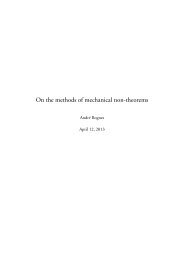The passive voice in written and spoken Scandinavian
The passive voice in written and spoken Scandinavian
The passive voice in written and spoken Scandinavian
You also want an ePaper? Increase the reach of your titles
YUMPU automatically turns print PDFs into web optimized ePapers that Google loves.
aspect (Hovdhaugen 1977: 24). <strong>The</strong> agent phrase is seldom overt <strong>in</strong> these<br />
constructions, <strong>and</strong> even if the addition of an agent would be grammatical <strong>in</strong> most<br />
cases, it is often considered unnatural, as shown <strong>in</strong> the follow<strong>in</strong>g example (ibid.):<br />
(7) Det ble dvelt lenge ( ? av dem) ved det problemet.<br />
it became dwelt-PART long time by them on this the.problem<br />
‘People were consider<strong>in</strong>g the problem for a long time.’<br />
<strong>The</strong> Swedish impersonal <strong>passive</strong> also presupposes human action, but the perceived<br />
agent cannot be expressed overtly through an av-phrase (Teleman et al. 1999 Vol. IV:<br />
363, Engdahl 2006: 38f). Moreover, the Swedish impersonal construction is only<br />
productive with the morphological form, whereas the periphrastic construction is<br />
highly restricted <strong>in</strong> this function (Engdahl 2006: 38f). Only some special<br />
constructions, as shown <strong>in</strong> example (8), are found. <strong>The</strong>se constructions are<br />
characterised, as po<strong>in</strong>ted out by Engdahl (ibid.), by a negative <strong>and</strong>/or quantitative<br />
phrase, such as e.g. <strong>in</strong>gent<strong>in</strong>g, ‘noth<strong>in</strong>g’, <strong>and</strong> <strong>in</strong>te mycket, ‘not much’, <strong>in</strong> (8a, b):<br />
(8) (a) Det blev <strong>in</strong>gent<strong>in</strong>g gjort. (Engdahl (2006: 39))<br />
it became noth<strong>in</strong>g done<br />
‘We got noth<strong>in</strong>g done.’<br />
(b) Det blev <strong>in</strong>te mycket sagt. (Engdahl (2006: 39))<br />
it became not much said<br />
‘Not much was said.’<br />
Besides the restrictions related to impersonal <strong>passive</strong> constructions, there exists at<br />
least one more limitation related to the Swedish periphrastic (bli) <strong>passive</strong>. It is<br />
po<strong>in</strong>ted out that these constructions tend to have animate subjects <strong>in</strong> Swedish<br />
(Teleman et al. 1999 Vol. IV: 390, Engdahl 2006: 31). <strong>The</strong> animacy aspect<br />
constitutes, however, only part of the explanation. More important is that the subject<br />
<strong>in</strong> periphrastic <strong>passive</strong> constructions tends to have some control over or effect on the<br />
situation described (Sundman 1983, Engdahl 2006: 32f). To have control or effect on<br />
an event obviously presupposes an animate subject.<br />
10

















